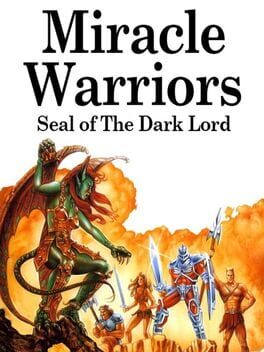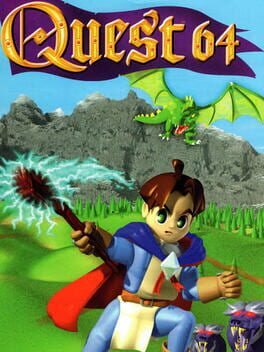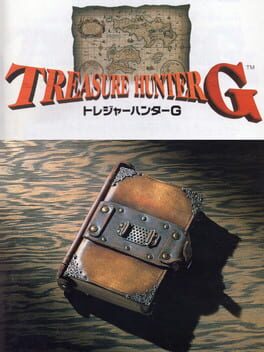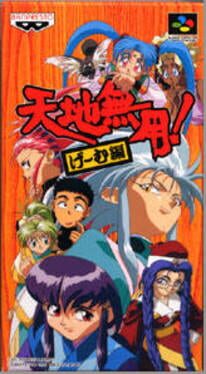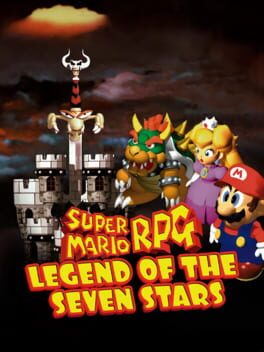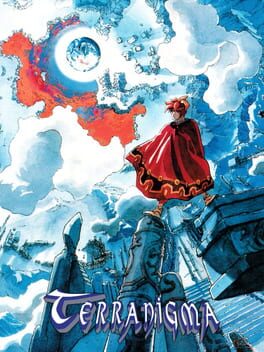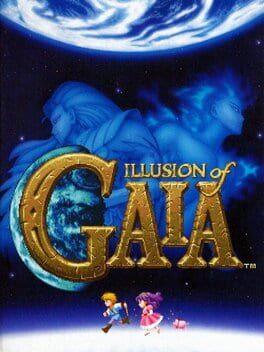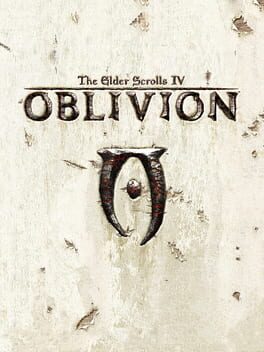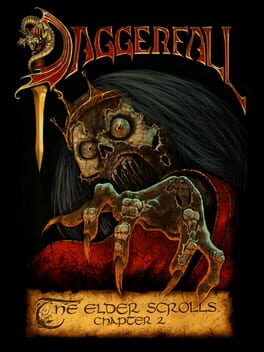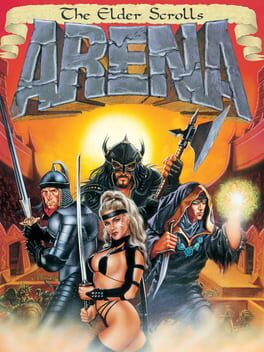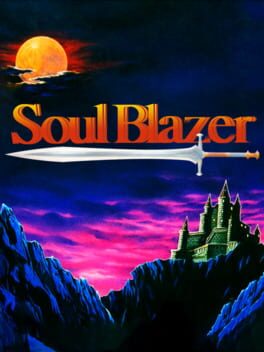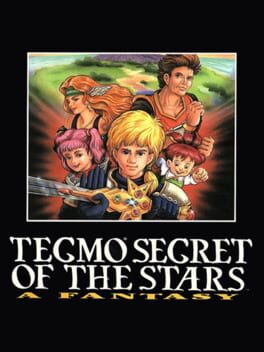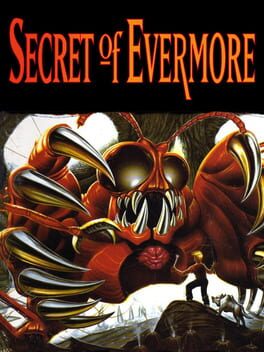Kogado's Miracle Warriors - one of the first JRPGs released in the west, stood apart with their battle quirks (e.g. only one character attacks per turn) and their juxtaposition of third-person & birds-eye viewpoints, with the former view focused on interactions and the latter on navigation. Its main drawbacks are simply the drawbacks of its generation: 3rd-gen combat was almost always slow and monotonous - bestowing challenge mainly through RNG (tough sporadic encounters, misses, escape chance, etc.), and this is no exception. Lofty grind-driven goals (for both equipment & progression) as well as hints, uneven fights and punishing setbacks are also effective time-killers built to mask its limited cart space. There are - however, some creative and perhaps visionary ideas at work. Popularity, a karma point value raised and lowered during battle, is the typical somewhat harsh system (plunging badly after defeating certain troops, and denying access to town services at low levels) that nevertheless feeds into its Talk command, a battle function that awards bonuses (tips, healing) or penalties (stolen gold, missed turns) from human encounters.
1998
Imagineer coined a uniquely minimal (level-less, item-limited, currency-less and party-less) form of JRPG with Quest 64, whose light storytelling, vast 3D areas and day/night cycles brought them closer to computer-RPGs than to its console-born siblings. What is undoubtedly CRPG-like - however, is their flexible upgrade system. Stat-leveling in the vein of FFII (i.e. earned from various parts of combat) is joined by collectible skill points distributed between 4 elements (which unlock new spells of that type and increase their power). Their combinations - from balanced spreads to a dual-type hyperfocus, governs the player's build with their own merits and limits. That sense of freedom well-complements their turn-based battles; seamless, responsive on-map gameplay with confined movement/dodging that's heavy on the spellcasting, reined in a little by elemental weaknesses and resistance. These two features rescue a work that otherwise would be dull and clumsy, as its lengthy overworld & dungeons plus a general dearth of content (other than a handful of pickups) make for some patience-testing trips. As a result, gameplay oscillates between moments of snappy, entertaining semi-action and sheer torture.
This brief project is many things at once, and - depending on taste, some conclusions are more prominent than others: A few great ideas placed on weak foundations. A half-baked mess. An interesting compromise between action & tactical gameplay. A novel fusion of Western/J-RPG languages, or even a grim omen of their genre's future; of the overscaled, empty worlds that progressively defined the next generation onwards. At the very least - though, a fascinating artifact of its era.
This brief project is many things at once, and - depending on taste, some conclusions are more prominent than others: A few great ideas placed on weak foundations. A half-baked mess. An interesting compromise between action & tactical gameplay. A novel fusion of Western/J-RPG languages, or even a grim omen of their genre's future; of the overscaled, empty worlds that progressively defined the next generation onwards. At the very least - though, a fascinating artifact of its era.
1996
Treasure Hunter G marked Sting Entertainment's initial venture into RPGs - pivoting around segmented, AP-driven tactics with the option to move/attack diagonally. Other components, both in-battle and out, further prove that this is far from the usual SRPG. Its creative weapon functions (e.g. spear attacks that also hit those directly behind the user) are backed by concepts not normally found in the genre, including DnD-esque item throws, tile-trapping, variable AP consumption (influenced by enemy proximity), random teleports and knockbacks. No less distinctive is their economy. Money is earned not via battles but by collecting/selling loot salvaged from environmental objects; interesting (and thematically sound) if not particularly exciting, a quality that also applies to its shops (purchasing items on display rather than from a menu) and puzzles (centered on riddles). They also craft detailed towns and interiors much like their publisher - but in general, combat is the prevailing feature here. With the help of preset fights a la Chrono Trigger (i.e. mob-activated & fixed ambushes taking place on the current map), these battles fuse the concise nature of encounter-based strategy with the design variety of their mission-based brethren, somewhere between Arc the Lad and Tactics Ogre.
On the other hand, its story and characters are hardly memorable, despite the amount of cutscenes and despite some truly strange moments - and, given their myriad variations in layouts, encounters are potentially hit or miss (with boss fights leaning towards the latter end).
On the other hand, its story and characters are hardly memorable, despite the amount of cutscenes and despite some truly strange moments - and, given their myriad variations in layouts, encounters are potentially hit or miss (with boss fights leaning towards the latter end).
Tenchi Muyo - developed by TamTam, was a mission-based, isometric, sci-fi TRPG based on the titular anime franchise. Between the simple battle maps & scenes is a level select hub with point-to-point locations that unlock different units (12 in total). Afterwards, a split-party gauntlet leads to another linear sequence of fights to close the story. Assuming that one couldn't care less about the characters, this release is ultra-short (clocking in at nearly 5 hours!), fairly easy, inoffensive but uneventful.
Mario's incursion into new genres continued with the Square/Nintendo collab of Super Mario RPG, that also paired action game precision with JRPG menu selection. Its combat is essentially Beyond the Beyond done right: Turn-based gameplay that grants bonuses upon synchronizing inputs to the impact of one's offense (e.g. heightened stats, extra turns) and defense (guarding), but with guaranteed damage rather than purely chance-driven side effects. Instead of magic types, Square's version of timing-oriented battling offers variety in a more tactile context. Weapons and abilities are characterized not only by their effects, but also by their skill check, and those variations are enough to distract from its below average pool of options (whether skills or allies) while helping them disguise what is - ultimately, the same battle approach of many console RPGs at the time (i.e. partitioning damage). What follows is straightforward and almost barebones, albeit with something to do in-between commands, an apparently simple feature which ends up distorting combat's flow (focused less on the menus and more on the animations) and tension (stemming from performance over prediction).
Outside battle mode are small, isometric 3D stages with traces of platforming and on-map mobs, alongside numerous ventures into minigames, unique scenarios, secrets (invisible blocks) and even Zelda-style challenges. The rest is - instead, little more than JRPG traditions dressed up with Super Mario's vibrant, colorful aesthetic, although with a few major exceptions: Stat-allocation (whose inherent replay value benefits from the game's length), the charming cast and above all a prevailing cartoony sense of humor. If its low difficulty leaves a bit to be desired, the experience is nonetheless well-produced and radiates wacky fun.
Outside battle mode are small, isometric 3D stages with traces of platforming and on-map mobs, alongside numerous ventures into minigames, unique scenarios, secrets (invisible blocks) and even Zelda-style challenges. The rest is - instead, little more than JRPG traditions dressed up with Super Mario's vibrant, colorful aesthetic, although with a few major exceptions: Stat-allocation (whose inherent replay value benefits from the game's length), the charming cast and above all a prevailing cartoony sense of humor. If its low difficulty leaves a bit to be desired, the experience is nonetheless well-produced and radiates wacky fun.
1995
Quintet's search for elegant and varied battling culminated with Terranigma, the final (and by far the best) part of their trilogy that struck the right balance of brawler, RPG and adventure ingredients. Moreover, it consolidated and polished ideas they established in the past: The platforming of ActRaiser, Soul Blazer's multifunctional equips, the Zelda influence and special attacks of Illusion of Gaia, and the premise of 'world restoration' (that connects these 3 games together) are expanded dramatically and set to slick production. But theirs is - above all, an action-RPG that's repetitive without feeling monotonous. New and versatile options (jump attacks, rapid strikes) complement the better ideas of IoG (KOF-style running, dash attacks with i-frames), and the result is an ever-fresh moveset whose execution seems closer to fighting games than to contemporaries (Seiken Densetsu 3, Secret of Evermore, etc.). Equally fortified - if not as complex, are its dungeons, where stronger elements of LoZ fuse with Metroid elements (unlockable auto-equipped skills, hard-to-reach treasure), while retaining their gift for original designs, scenarios and aesthetics. They also mark a return to form for their RPG side (EXP & item-based upgrades in place of its predecessor's collect-a-thon-esque approach), and - for once, their bosses are fun to challenge, although one wonders if that's more so due to their designs or combat's merits.
It's not only gameplay that excels: Early-game dungeons are followed closely by vibrant, warped, almost psychedelic cutscenes played in slow-motion, that achieve disorienting effects via creative use of Mode 7. When the trip subsides, these scenes begin to depict more traditional but no less poignant stories whose ecological, historical and humanitarian themes reveal the true soul of the Gaia series. Whereas Soul Blazer was more preoccupied with gameplay, and IoG with personal subplots, here their storycrafting skills advanced to a whole new level of maturity. More than a meticulous update, this is one of those rare SNES games that are as much a visual treat as a functional & narrative one.
It's not only gameplay that excels: Early-game dungeons are followed closely by vibrant, warped, almost psychedelic cutscenes played in slow-motion, that achieve disorienting effects via creative use of Mode 7. When the trip subsides, these scenes begin to depict more traditional but no less poignant stories whose ecological, historical and humanitarian themes reveal the true soul of the Gaia series. Whereas Soul Blazer was more preoccupied with gameplay, and IoG with personal subplots, here their storycrafting skills advanced to a whole new level of maturity. More than a meticulous update, this is one of those rare SNES games that are as much a visual treat as a functional & narrative one.
1993
Illusion of Gaia - presumably Soul Blazer's follow-up, set aside the town-building elements and opted for a linear, story-heavy action-adventure. This new approach awards stat boosts upon defeating monster rooms rather than hub progress, with unlockable special attacks serving as tools. But it's hard not to be reminded of Seiken Densetsu (and in particular its sequel, released a few months before IoG) while playing this Zelda/RPG hybrid: Unlike SD2, they aren't afraid to dabble in puzzles (best represented by its dedicated gimmick rooms). Unlike SD2, they can graft Zelda's clever solutions to the unique scenarios of JRPGs, and unlike SD2, combat's variety doesn't hinge on weapon types & magic (offering transformations, beat-em-up-esque collisions and follow-up strikes instead). They also compare favorably in regards to characters, dungeon designs + aesthetics, storytelling (whose emphasis, themes and quality were rare among action games at the time) and animations, losing only when it comes to battles (that turned to LoZ-grade poking with a few add-ons). If the RPG integration feels more cinematic than functional, and they've yet to learn how to balance boss fights, this game succeeds at recreating Final Fantasy Adventure from another - more narrative-driven and puzzle-y angle.
TES' fifth main installment in 17 years was Skyrim, ostensibly their mature statement but in reality a sterile blockbuster that continues their trend towards storytelling, action and production at the cost of depth. This streamlined adventure favors a universal freelancer-like build with minimal influence from character creation. It's no longer an RPG in that there's no particular 'role' to follow, as differences among elements and weapon types feel trivial, and better customization is determined by enchanting, smithing and alchemy skills (that - alas, rely too much on menu routine). Without Acrobatics or key alteration spells, navigation is reduced to endless jogging, sprinting and mountain goat-ing towards a single point if one isn't fast-traveling already, like Daggerfall with fewer incentives. On the other hand, this contains their best-feeling combat (not exactly an achievement), and their OST and visuals continue to impress (until the next step in graphical tech arrives). It is telling that - despite the cinematics and setpieces of their main campaign, two of its peaks involve exploration: dwemer ruins and the 7000-step climb.
The trajectory of The Elder Scrolls - from rough freeform complexity to polished, restrictive 'streamlining', reached a magical balance with Morrowind. But the release of Oblivion began their descent towards the latter end, of guided storytelling, less complex RPG mechanics, fully-action combat and lush environments, i.e. towards greater mass appeal. Like its predecessor, much of the intrigue is owed to its playstyles. This time it's the leveling system that influences gameplay, and in particular their major/minor skills, of which only the former awards level EXP. When played normally (as in: selecting the right major skills for one's intended build), the experience suffers from oppressive level-scaling and chronically weak combat. When played in reverse (as in: by assigning seldom-used talents as major skills), the player is faced with an oddly accommodating RPG. Morrowind had balanced this by way of dice rolls, which made building low-level misc skills (here known as minor skills) especially difficult without a trainer. Their absence this time around allows one to easily hone talents regardless of the character's class, and even stay at level 1 for hundreds of hours (although exempted from major quests and stuck with lesser treasure). It's yet another exploit-prone system, but the exploit's effect on gameplay is unusual: Players level up with complete agency and ideally when prepared to increase the difficulty & loot. As skills improve, the attribute bonuses of old lead to carefully-sculpted builds reminiscent of Pokemon's EV-training.
Acrobatics (or regular jumping in general) replaced jump spells as the alternative means of world traversal, now equipped with much better air control that - at high levels, turns areas into quasi-platformer stages (with potential to sequence-break dungeons). The rest is a mixed bag that's heavier on the negatives: Features such as spellmaking and enchanting are tidied up and locked behind quests. Weapons lack feedback despite removing skill-based hit chance. The icon compass and a return to fast-travel-from-anywhere detract from the sense of discovery. And finally the inclusion of voiced dialogue (more than a line or two) indirectly reduces the quality of writing, but that does little to hurt their scenario-building.
Acrobatics (or regular jumping in general) replaced jump spells as the alternative means of world traversal, now equipped with much better air control that - at high levels, turns areas into quasi-platformer stages (with potential to sequence-break dungeons). The rest is a mixed bag that's heavier on the negatives: Features such as spellmaking and enchanting are tidied up and locked behind quests. Weapons lack feedback despite removing skill-based hit chance. The icon compass and a return to fast-travel-from-anywhere detract from the sense of discovery. And finally the inclusion of voiced dialogue (more than a line or two) indirectly reduces the quality of writing, but that does little to hurt their scenario-building.
Six years and a switch in directors, platform and setting led to their slowest but also their most intense and atmospheric work. Morrowind - however, is actually two games in one: The deliberate explorer and the moon-jumping alteration mage. The former is where the trademark 'haunting' component of dungeon-crawlers takes over the world, turning it into an agonizing wasteland in which the mood, weather, wildlife and natives are all hostile in their own way. It's also a classic example of exploration, first by dropping the tutorial dungeons, reducing fast travel to a paid service and - after a few minutes of walking and character creation, begins by wishing the player "good luck!". What comes next is perhaps the most 'involved' form of navigation ever. Via signposts, checking for directions (using a quest menu that takes after a messy journal) and frequent use of the map, players basically perform the gameplay loop of towns in prior TES games outwards. A similar process also affects its structure, as Daggerfall's dungeon verticality translates into complex world geometry (hills, mountains, valleys, even floating areas). The addition of random encounters (not only while resting, and whose rate becomes comical lategame) lends a new layer of tension to traversal, and in-between - their talent for strange-but-memorable moments shows in its roadside quests.
Alteration spells define the other side of their program, a hyper-busted strategy where magic becomes as freely explorable as its world. Movement-related ones such as levitate, jump and slowfall take on higher parameters - with access to more extreme effects via spellmaking, and the result is a progressively wild game of 'fast travel' in which players cross incredible distances with a single leap. Levitation - in particular, revolutionizes dungeon progression the way that Jump does to the overworld, while other spell types, whether new (conjuration) or expanded (illusion & mysticism), also benefit from the bugs/oversights of such a wonderfully broken spellcrafting system. Essentially, users must choose between slow-burn wandering and a superhero sim. What these two playstyles have in common is that the overworld is now the centerpiece.
Not every change is a huge plus (e.g. verbose topic-based dialogue system, combat that relies heavily on stamina) but the rest marks a major step forward in quality, variety and personality.
Alteration spells define the other side of their program, a hyper-busted strategy where magic becomes as freely explorable as its world. Movement-related ones such as levitate, jump and slowfall take on higher parameters - with access to more extreme effects via spellmaking, and the result is a progressively wild game of 'fast travel' in which players cross incredible distances with a single leap. Levitation - in particular, revolutionizes dungeon progression the way that Jump does to the overworld, while other spell types, whether new (conjuration) or expanded (illusion & mysticism), also benefit from the bugs/oversights of such a wonderfully broken spellcrafting system. Essentially, users must choose between slow-burn wandering and a superhero sim. What these two playstyles have in common is that the overworld is now the centerpiece.
Not every change is a huge plus (e.g. verbose topic-based dialogue system, combat that relies heavily on stamina) but the rest marks a major step forward in quality, variety and personality.
Their ambition paid off with the even more systems-driven world of Daggerfall, a diligent update of Arena that revealed their knack for unusual quest scenarios. Visual upgrades (to towns, overworld, dungeons, menus, NPCs, etc.) match functional (movement and command shortcuts) and QoL upgrades (town maps, mounts, storage), while surrounding mechanics (from character creation to dialogue systems) evolve into far more sophisticated features. But its best evolution is perhaps the least visible one. Use-based EXP - that previously only refined spells, expands FFII's weapon-oriented approach to many aspects of gameplay (e.g. running, climbing, conversations, mercantile, and others beyond combat and magic). While prone to repetition & exploits, this is perhaps their most significant idea, a gradual leveling system that treats gameplay's habits like a muscle: The more you use it, the better it gets. Its effect was to instill a new, parallel sense of purpose to decisions. For example, Arena's overworld doubles as a training ground here, as its vacant, prop-y layout helps build movement skills while random encounters (on rest) hone others, adding impetus to open-world roaming that the original lacked. Dungeons also deserve mention for incorporating seamless staircases, monster closets, underwater sections, teleports and many other additions from the classics, while remaining lengthy, dense, maze-y networks.
Much like their debut, though, the main quest could benefit from some editing, although one admits that the side content (the collective moments and not the journey/destination) forms the lifeblood of the game this time. Incidentally, one feels a lot more 'immersed' in this land as a mercenary trying to make profit than as a venturing hero.
Much like their debut, though, the main quest could benefit from some editing, although one admits that the side content (the collective moments and not the journey/destination) forms the lifeblood of the game this time. Incidentally, one feels a lot more 'immersed' in this land as a mercenary trying to make profit than as a venturing hero.
Bethesda Softworks tried their hand at RPGs with The Elder Scrolls: Arena, a first person adventure across a 'giant' landmass split into provinces. On the dungeon-crawler side, these serpentine mazes - complete with limited vision, frequent encounters and weak combat (utilizing mouse movement to perform weapon swings), at least feature two somewhat original concepts: Waterways (i.e. small paths traveling through rooms & under walls, sometimes used as shortcuts and other times as complex sub-mazes) and the Passwall ability (that enables one to destroy walls and therefore bypass locked doors for speedy dungeon clearing). Even more notable are the magic systems, namely a use-based means of leveling reminiscent of Final Fantasy II (governing not stats but the cost, efficacy and duration of spells); and above all the free-form craft of spellmaking, where players could not only combine and alter magic, but even adjust the degree in which those spells' properties improve. Their grind-driven exploits would become one of TES' constants.
The overworld side is vastly inferior. Procedural generation - in this case, underwhelms in terms of environments (composed of flatland and small props), action (surprise encounters only on rest) and discovery (the occasional random dungeon with weak treasure). Main quest playthroughs are better served by fast travel, while those interested in exploring won't find much to salvage (loot, enjoyment, etc.). Ditto for its many towns, whose differences exist only in the layouts, although the combo of a question-filled dialogue system, a limited map, and wandering NPCs gives their navigation a funny quality: As de facto foreigners who cannot easily spot landmarks, players must resort to asking locals for directions.
All in all, between an excessively long main route (given its rather simple plot & structure), pointless job quests (compared to the treasure found in main dungeons), and finicky controls that seem designed for 3-handed people, one suspects that its real achievements (embodied by its massive lorefest of a setting) are not gameplay-related, but rather in the technical, cosmetic and worldbuilding departments.
The overworld side is vastly inferior. Procedural generation - in this case, underwhelms in terms of environments (composed of flatland and small props), action (surprise encounters only on rest) and discovery (the occasional random dungeon with weak treasure). Main quest playthroughs are better served by fast travel, while those interested in exploring won't find much to salvage (loot, enjoyment, etc.). Ditto for its many towns, whose differences exist only in the layouts, although the combo of a question-filled dialogue system, a limited map, and wandering NPCs gives their navigation a funny quality: As de facto foreigners who cannot easily spot landmarks, players must resort to asking locals for directions.
All in all, between an excessively long main route (given its rather simple plot & structure), pointless job quests (compared to the treasure found in main dungeons), and finicky controls that seem designed for 3-handed people, one suspects that its real achievements (embodied by its massive lorefest of a setting) are not gameplay-related, but rather in the technical, cosmetic and worldbuilding departments.
1992
The first in Quintet's 'unofficial' Gaia series, Soul Blazer is an action-RPG whose gameplay reimagines LoZ as a chapter-based, pseudo-town builder propelled by clearing waves of enemies in dungeons. i.e. Battle encounters could spawn quest points found in their corresponding level's hub, which take the form of buildings, hint-giving NPCs and special loot. The most interesting of which is found in the latter - namely their accessories and armor, equipped items with a range of extra abilities (whether to circumvent hazards or enter areas) that have more in common with Zelda than with ARPGs. By pairing those tools with the fragmented, gradually-expanding design of its trials (unravelling in tandem with hub unlocks and vice-versa), they offer a mini version of classic overworld-to-dungeon progression, but in discrete segments rather than a rigid dichotomy. And - along the way, plenty of shortcuts facilitate the frequent backtracking expected of this action-to-adventure loop. In their hands, dungeon-crawling is not necessarily about finding the boss/exit.
Its only weak point is the combat, a fast-paced albeit repetitive and somewhat awkward system in which enemies don't respond to offense; no knockback & no stun, just a split second blink as they continue forward. Those user attacks - however, sport a wildly disjointed hitbox that can pierce through obstacles, effectively inspiring players to hide behind walls, corners or pillars (or a few steps from the spawner) and cast or hack away at approaching foes. Its potential is perhaps better demonstrated in later stages and during boss fights (with a few painful exceptions). Regardless, Quintet engineered a challenging and unique form of crawler that is recursive but not quite rogue-like, thus possibly laying the foundations for Dark Cloud.
Its only weak point is the combat, a fast-paced albeit repetitive and somewhat awkward system in which enemies don't respond to offense; no knockback & no stun, just a split second blink as they continue forward. Those user attacks - however, sport a wildly disjointed hitbox that can pierce through obstacles, effectively inspiring players to hide behind walls, corners or pillars (or a few steps from the spawner) and cast or hack away at approaching foes. Its potential is perhaps better demonstrated in later stages and during boss fights (with a few painful exceptions). Regardless, Quintet engineered a challenging and unique form of crawler that is recursive but not quite rogue-like, thus possibly laying the foundations for Dark Cloud.
Tecmo's foray into JRPG land yielded Aqutallion - a.k.a Secret of the Stars, a Dragon Quest-like that more or less complies with the rules of the genre. In between a QoL-minded approach and plenty of creative moments (although one has to wait until the second half to find something memorable), its main 'feature' allows players to switch control between 2 parties - a system occasionally used for dungeon & loot access, but also a clear attempt at doubling the time spent grinding.
1995
The only Square game designed in north america, Secret of Evermore proved to be more than just a western Mana epigone. Regional differences are visible in its writing & main characters, while gameplay/system ones such as alchemy - which simply adds crafting materials to leveled spells (mainly for RPG utilities but also for mild Zelda-like progression), offer partial but more intriguing twists on the source. Its combat follows a similar approach; top-down brawling modeled after Secret of Mana (ring menu, stamina, charge attacks, battler-swapping, etc.) but without the ability to vortex and push foes around (as knockdowns last for a fraction of what they used to), focused instead on evasive movement, brief stuns and follow-up attacks from a companion. In a sense, it's closer in concept to the original Seiken Densetsu than to its follow-ups, although updated with the speed of SD2 and the flow of SD3. If its production pales when compared to mainline Manas, Evermore managed to surpass them in other areas, from enemies (trickier and more diverse in design) to sprinting (that controls more freely than SD2's pegasus boots-ian dash), from progression (quasi-levels that leave the world map for much later) to dungeons (lengthier and far more creative). Not everything works - though: Its weapons feel samey beyond their niche, bosses are as varied as they are annoying, and the second half disappoints, relying too heavily on mazes, hidden paths and backtracking to confuse the player.
